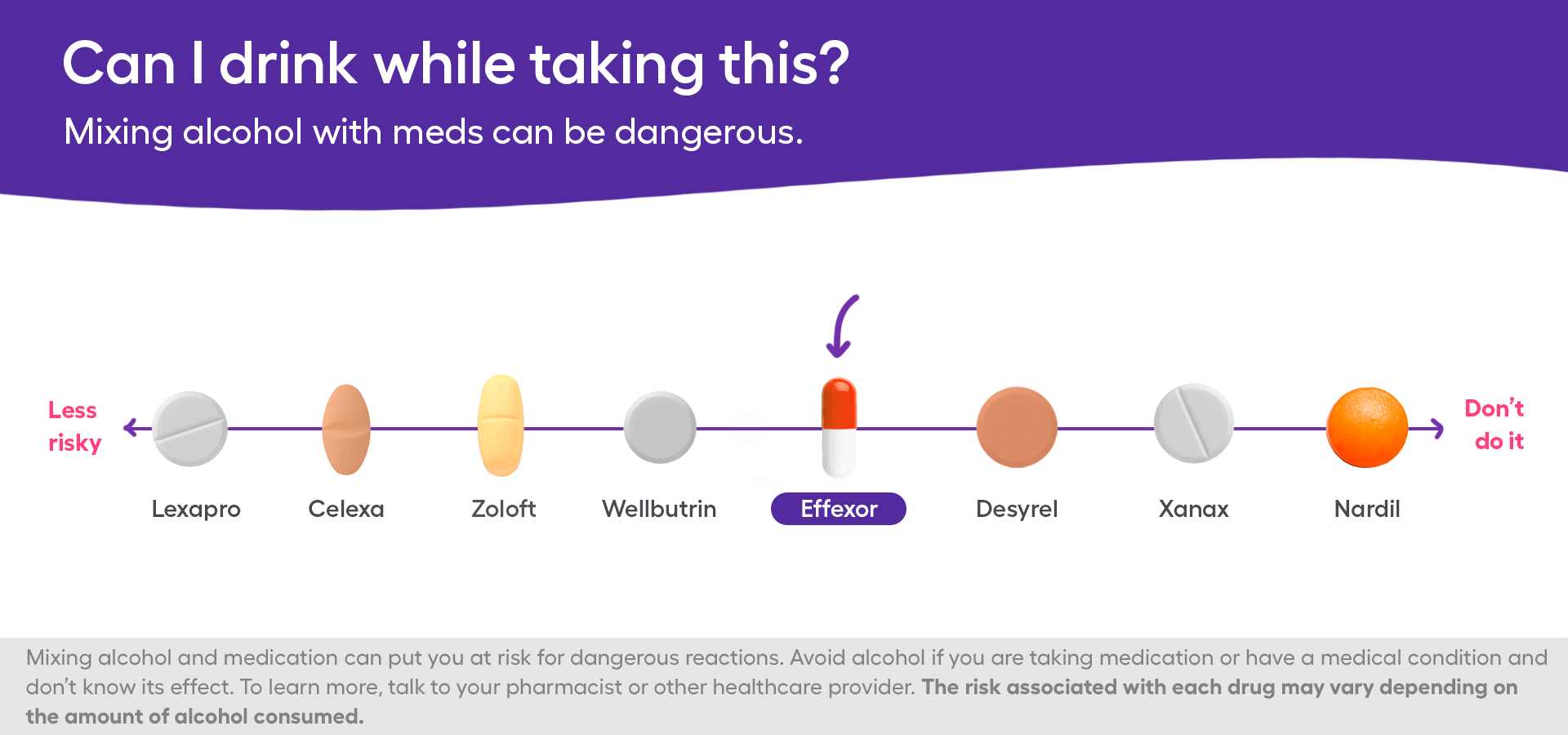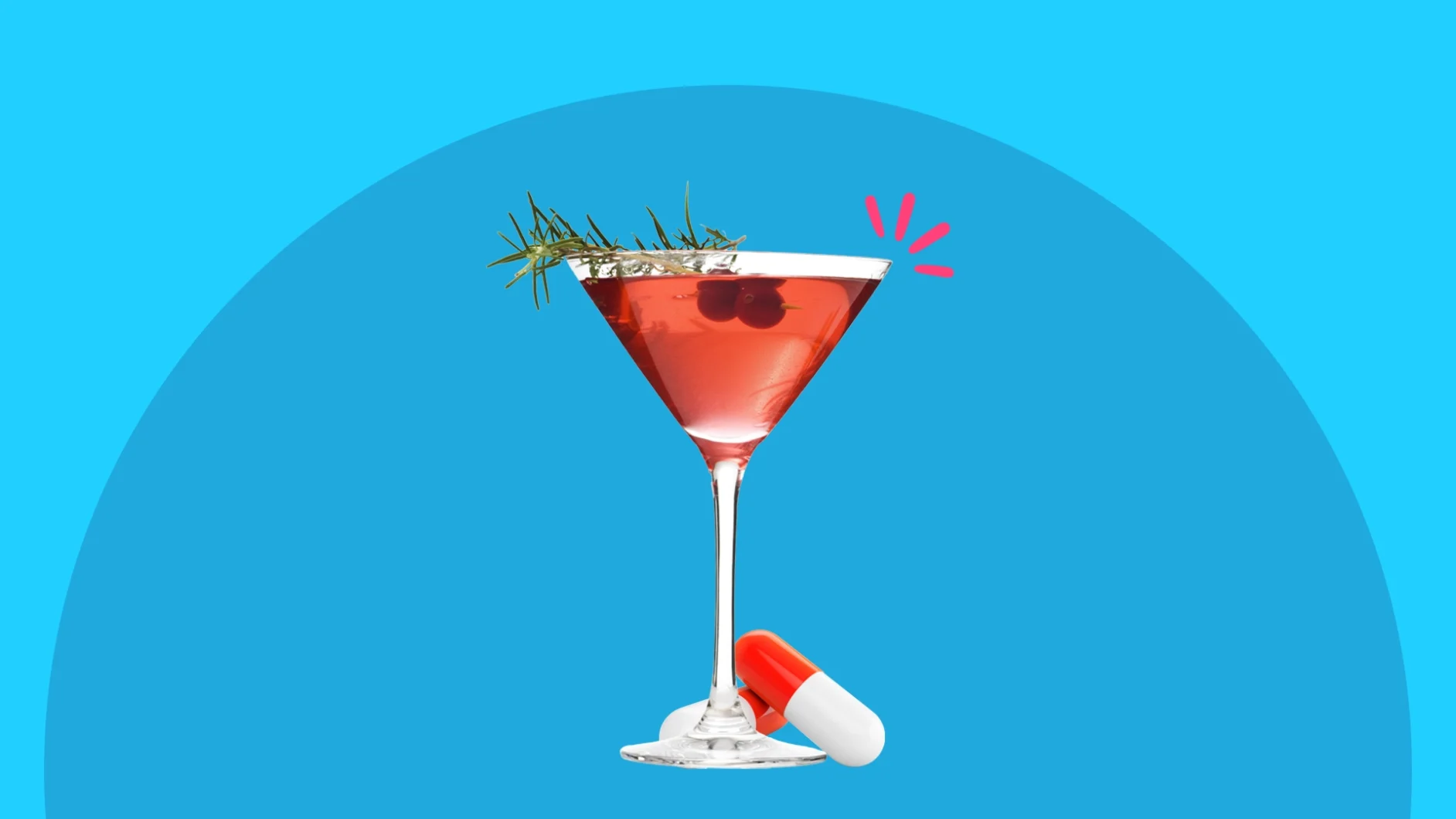Key takeaways
Drinking alcohol while taking venlafaxine can worsen side effects like nausea, drowsiness, and sexual dysfunction.
Mixing venlafaxine with alcohol may increase the risk of serious complications, including serotonin syndrome and bleeding.
Some people may be able to drink in moderation with a provider’s guidance if they understand how both substances affect them.
Venlafaxine, commonly known by the brand name Effexor or Effexor XR, is a prescription drug used to manage symptoms of depression and other mood disorders. After being prescribed venlafaxine, you might wonder about your lifestyle choices while on this drug. A common question arises when people get invited to a social gathering or celebration—can you enjoy a drink while taking venlafaxine?
Though some people might be tempted to have a drink at a wedding or during dinner with friends, the medication label clearly advises against it. The risks aren’t just about feeling extra drowsy; Combining venlafaxine and alcohol may increase bleeding risks and worsen other central nervous system (CNS) side effects. Even if you feel your symptoms are improving on Effexor, drinking alcohol could interfere with your treatment progress.
How is venlafaxine typically taken?
Venlafaxine is an antidepressant that belongs to a class of drugs called serotonin-norepinephrine reuptake inhibitors (SNRIs). It works by increasing the levels of certain neurotransmitters, namely serotonin and norepinephrine, in the brain. As a result, it may help improve mood, energy, and overall well-being. Healthcare providers commonly prescribe venlafaxine to treat depression and certain anxiety disorders.
It’s specifically approved by the U.S. Food and Drug Administration (FDA) to treat major depressive disorder, generalized anxiety disorder, social anxiety disorder, and panic disorder. Some healthcare providers may also prescribe it off-label for other conditions like hot flashes, nerve pain, migraines, and premenstrual dysphoric disorder.
Venlafaxine comes in two main forms: immediate-release tablets and extended-release capsules. The immediate-release form (regular Effexor) is typically taken two to three times per day, while the extended-release form (Effexor XR) is taken just once daily. Brand-name Effexor is no longer available in the U.S.
Can you drink while taking venlafaxine?
Generally, it’s not recommended to drink alcohol if you take venlafaxine. The FDA warns that people should avoid alcohol while being treated with venlafaxine, as combining them can be dangerous and worsen side effects. Alcohol can increase CNS side effects and potentially lead to increased depression or anxiety symptoms.
If you’re prescribed venlafaxine, it’s important to consult your healthcare provider for medical advice regarding alcohol use. Some doctors may allow occasional, moderate drinking after reviewing your overall condition, especially if you’re an otherwise healthy adult. However, even small amounts might cause stronger reactions than expected.

What happens if you mix venlafaxine and alcohol?
Combining venlafaxine with alcohol can lead to several health effects, some of which can be serious. The interaction between venlafaxine and alcohol intensifies the side effects of both substances and creates new risks that might not occur when taking either alone.
Nausea
Nausea is one of the most common side effects when mixing venlafaxine and alcohol. Both substances can cause stomach upset on their own, but taking them together can cause a stronger reaction. Some people might report feeling queasy within hours of drinking while on venlafaxine. Nausea may last longer than expected and can be more difficult to manage than regular hangover symptoms. For some, nausea becomes severe enough to cause vomiting.
Dry mouth
Mixing venlafaxine and alcohol can worsen dry mouth, which is a common side effect of both. A dry mouth can cause discomfort and make it hard to swallow. Alcohol can also dehydrate you, making your dry mouth feel even more uncomfortable.
Drowsiness
Combining venlafaxine and alcohol can lead to increased drowsiness, making you feel unusually tired or sleepy. This can be dangerous, especially if you’re driving or operating machinery. What feels like having “just one drink” may lead to cognitive impairment equal to several drinks while taking venlafaxine. The drowsiness may persist longer than expected, sometimes lasting into the following day.
Sexual dysfunction
Like other antidepressants, venlafaxine may cause sexual dysfunction. Decreased libido, erectile dysfunction, and delayed orgasm are potential side effects of venlafaxine. Drinking alcohol can also cause difficulties in sexual performance or satisfaction. Combining venlafaxine and alcohol may compound this effect, which may become frustrating and affect relationships.
Serious side effects of mixing venlafaxine and alcohol
Mixing venlafaxine with alcohol can lead to more serious side effects. In rare cases, these effects may be life-threatening.
Liver problems
The liver works hard to process both venlafaxine and alcohol, which can make it more vulnerable when these substances are combined. While venlafaxine can cause slight changes in liver tests in less than 1% of people using it, these changes are usually mild and don’t require stopping the medicine. However, there have been rare cases of serious liver injury occurring within a few months after starting the treatment. Since alcohol is known to cause liver issues, mixing it with venlafaxine could increase the chances of liver problems, especially for those who are already at a higher risk.
Increased bleeding risk
Venlafaxine, like other SNRIs and selective serotonin reuptake inhibitors (SSRIs), can affect how platelets work, which may increase the risk of bleeding. Alcohol can also act as a blood thinner, amplifying the risk. Taking venlafaxine and alcohol together may lead to bleeding events, such as bruises, nosebleeds, or other internal bleeding problems. The risk of bleeding may be even more pronounced if you’re taking other blood thinners, such as warfarin or aspirin.
Serotonin syndrome
Serotonin syndrome is a potentially serious condition that can occur when there are excessive levels of serotonin in the brain. Symptoms can include confusion, rapid heart rate, sweating, shivering, muscle twitching, and changes in blood pressure. There have been reports of serotonin syndrome in people combining antidepressants and alcohol. Therefore, serotonin syndrome is a serious concern when mixing venlafaxine and alcohol. If not treated quickly, serotonin syndrome can be life-threatening.
Overdose
Mixing Effexor with alcohol may increase the risk of an overdose with venlafaxine. Most cases of venlafaxine overdose have occurred when venlafaxine was mixed with alcohol. Symptoms of an overdose can include a fast heart rate and drowsiness. Other signs to look out for include dilated pupils, seizures, and vomiting. In more serious cases, heart rhythm problems, low blood pressure, dizziness, liver damage, serotonin syndrome, and even death can occur. In addition, a study found that combining alcohol with venlafaxine may lower the threshold for fatal alcohol overdoses.
The severity of side effects from mixing venlafaxine and alcohol can vary. While some may experience strong reactions or serious health risks, others might not notice any adverse effects at all.
Are certain people at greater risk of side effects?
Some people may face increased risks of adverse effects from venlafaxine, especially when combined with alcohol. Therefore, taking an appropriate dosage and using extra caution may be particularly important.
Older adults
Older adults may be more likely to experience more severe side effects when mixing venlafaxine and alcohol. That’s because drug metabolism can slow with old age. In other words, older people can take longer to process venlafaxine and alcohol, resulting in higher amounts of each in their system. An older adult might experience more dizziness, drowsiness, and trouble with coordination than younger people. This can increase the risk of falls, which is especially risky for older individuals.
People with kidney problems
People with kidney impairment may be unable to clear venlafaxine from their system efficiently, which can cause the drug to build up in the bloodstream and lead to more side effects. For those with kidney problems, healthcare providers usually recommend lowering the venlafaxine dose by up to 50% or more. Alcohol further strains the kidneys while also intensifying the side effects of Effexor.
People with liver problems
The liver is important for breaking down both venlafaxine and alcohol. People with liver problems process these substances more slowly, which can make their effects stronger and last longer. Those with liver issues usually need to take at least 50% less venlafaxine. Drinking alcohol while on venlafaxine can be risky for these individuals, leading to greater drowsiness, trouble with coordination, and an increased risk of a venlafaxine overdose.
How long after taking venlafaxine can you drink alcohol?
Venlafaxine has a half-life of around five hours, while its active metabolite (ODV) has a longer half-life of approximately 11 hours. Half-life refers to the time it takes for half of the drug to be eliminated from your body. Generally, a medication is considered mostly cleared from your system after four to five half-lives.
Therefore, it takes around 20 to 25 hours for the primary drug to be mostly eliminated but 44 to 55 hours (nearly two to three days) for its active metabolite to clear. During this time, mixing venlafaxine with alcohol may carry a risk of side effects. If you want to be extra safe, you’ll want to wait at least a couple of days after stopping venlafaxine before drinking alcohol.
Keep in mind that people who abruptly stop taking venlafaxine may experience withdrawal symptoms like dizziness, nausea, headache, and irritability. If you’re considering stopping venlafaxine, you’ll want to work with a healthcare provider who can help with tapering your dosage rather than stopping suddenly. Withdrawal symptoms can worsen when combined with alcohol.
Are all antidepressants affected by alcohol?
Most antidepressant medications may interact with alcohol. The way alcohol interacts with these medications can vary based on the specific type of antidepressant you are taking, how your body responds to both alcohol and the medication, how long you’ve been on the treatment, and how much alcohol you drink.
Mixing alcohol with antidepressants can make side effects worse, reduce how well the medication works, and even lead to serious health risks. Alcohol itself may also worsen mental health conditions over time. Studies suggest a strong link between worsening mental health and increased alcohol consumption.
Antidepressants that may interact with alcohol include:
- SSRIs
- Prozac (fluoxetine)
- Zoloft (sertraline)
- Lexapro (escitalopram)
- Tricyclic antidepressants (TCAs)
- Elavil (amitriptyline)
- Tofranil (imipramine)
- Pamelor (nortriptyline)
- Monoamine oxidase inhibitors (MAOIs)
- Nardil (phenelzine)
- Parnate (tranylcypromine)
- Marplan (isocarboxazid)
- Atypical antidepressants
- Wellbutrin (bupropion)
- Remeron (mirtazapine)
A healthcare provider can help you explore different treatment options if venlafaxine is not right for you. Always consult a healthcare provider about all medications you take, including prescription drugs, over-the-counter (OTC) medicines, and herbal supplements, before starting treatment, especially if you regularly consume alcohol.
The bottom line
Drinking alcohol while taking venlafaxine is not typically recommended. It can worsen side effects like drowsiness, nausea, and dry mouth. Mixing these two can also increase the risk of serious issues like liver damage, bleeding, and serotonin syndrome. In addition, alcohol may reduce how well the medication works and could lead to an overdose. People with liver or kidney problems, as well as older adults, are at greater risk when combining alcohol with venlafaxine.
Some people may be able to drink in moderation with a provider’s advice. However, consider talking to a healthcare professional before drinking alcohol, and wait two to three days after stopping the medication before having any drinks.
- Highlights of prescribing information, U.S. Food and Drug Administration (2023)
- Highlights of prescribing information, U.S. Food and Drug Administration (2012)
- Drink alcohol only in moderation, Office of Disease Prevention and Health Promotion (2025)
- Alcohol-associated sexual dysfunction: How much is the damage?, Medical Journal Armed Forces India (2024)
- Venlafaxine, desvenlafaxine, LiverTox (2020)
- Venlafaxine, StatPearls (2024)
- Serotonin syndrome after an alcohol intake in a patient treated with escitalopram and clomipramine, Clinical Neuropharmacology (2019)
- Newer antidepressants: evaluation of fatal toxicity index and interaction with alcohol based on Finnish postmortem data, International Journal of Legal Medicine (2005)
- Pharmacokinetics in older adults, Merck & Co., Inc. (2022)
- Venlafaxine: A structurally unique and novel antidepressant, Sage Journals (1995)
- Associations of common mental disorder with alcohol use in the adult general population: a systematic review and meta‐analysis, Addiction (2021)




